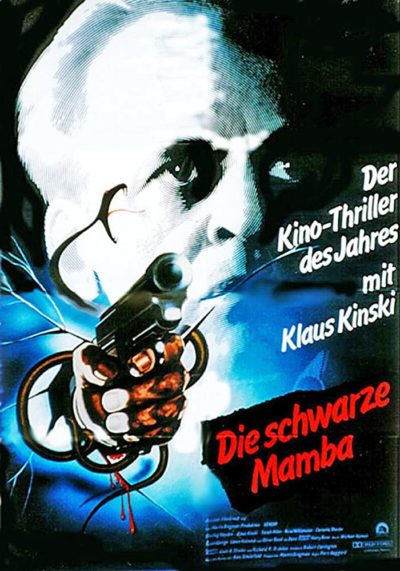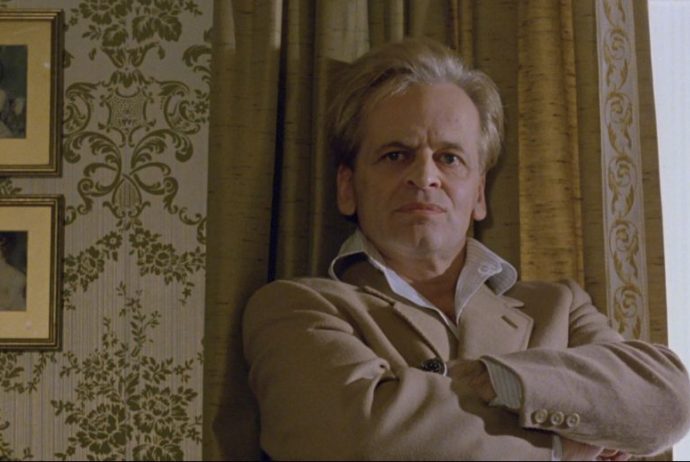Dir: Piers Haggard
Star: Klaus Kinski, Oliver Reed, Sterling Hayden, Nicol Williamson
 To mis-quote Mike Tyson, “Everybody has a plan until they get bitten by a black mamba.” That’s the scenario here, where an attempted kidnapping by German criminal Jacques Müller, a.k.a. Jacmel (Kinski) and his gang goes thoroughly pear-shaped, for two reasons. Firstly, associate Dave Averconnelly (Reed) blows away a policeman on the doorstep of the house, which causes the local police, under Commander William Bulloch (Williamson), to descend, en masse. Secondly, due to an very unfortunate error in the shipping department, the supposedly inoffensive pet snake ordered by the young kidnapping target gets swapped out for an annoyed and highly poisonous alternative.
To mis-quote Mike Tyson, “Everybody has a plan until they get bitten by a black mamba.” That’s the scenario here, where an attempted kidnapping by German criminal Jacques Müller, a.k.a. Jacmel (Kinski) and his gang goes thoroughly pear-shaped, for two reasons. Firstly, associate Dave Averconnelly (Reed) blows away a policeman on the doorstep of the house, which causes the local police, under Commander William Bulloch (Williamson), to descend, en masse. Secondly, due to an very unfortunate error in the shipping department, the supposedly inoffensive pet snake ordered by the young kidnapping target gets swapped out for an annoyed and highly poisonous alternative.
The critter escapes, and spends the rest of the time slithering around the house, popping out at appropriately dramatic moments, e.g. Dave’s attempt to get a drink out of the cocktail cabinet. It also crawls up the leg of Oliver Reed’s pants, allowing every review to make the obvious “trouser snake” joke except this one, which will not stoop to such depths. Fortunately, the boy’s grandfather, Howard Anderson (Hayden) was a bit of a big game explorer in his heyday, and is another of Jacmel’s hostages. The toxicology doctor for whom the mamba was intended also ends up inside the house, so in terms of herpetelogical expertise, I’d say they were doing quite well, overall. However, between the cops outside and the reptile inside – and by that, I don’t mean Klaus – it’s safe to say that things are not proceeding quite in the way Jacmel expected.
According to Klaus
“I pick Venom, because the salary is very high, even though I hate London, where the flick’s to be shot.”
This was, famously, the film for which Kinski rejected the role of Major Arnold Toht in Raiders of the Lost Ark, calling the Indiana Jones script “as moronically shitty as so many other films of this ilk.” He also turned down Claude Lelouch’s Les Uns et les Autresi, purely for mercenary reasons: “Not for the shabby pittance that this rat offers me.” Which is how he came to be here, part of perhaps the best cast put together for one of Kinski’s B-movies: as well as the above, there is also Susan George, who plays the house maid and another collaborator with Jacmel, plus Michael Gough and Sarah Miles.
Shooting had already started under Tobe Hooper (Texas Chainsaw Massacre), but nine days in, he had to be replaced – not for the first time in Hooper’s career. Some sources say there was an illness in his family; alternatively, writer David Sherwin, who worked on some of the early drafts, says in his biography that Hooper “had a nervous breakdown.” Whether making a movie with Klaus was involved, will remain one of history’s mysteries, but an unsourced claim in the trivia section on IMDb says, “At a party at Elaine’s Restaurant in Manhattan celebrating the film’s release, Klaus Kinski boasted how he and other members of the cast and crew had ganged up on Hooper a couple of weeks into the shoot to get him replaced.”
Due to Hooper’s unexpected exit, Haggard was thrown in as his replacement to take over, with no pre-production time. Given this, he deserves credit simply for being able to produce something coherent and in focus, though he ended up junking all the footage shot by Hooper. That went for some of the stylistic choices his predecessor had made too, with regard to costumes and lighting. On the DVD commentary, Haggard says Hooper “had Klaus as a grim Nazi and I thought that was quite wrong and outdated… It was all sort of derivative of Fritz Lang, all lit from below… kind of a bit stereotyped.”

You wonder what the end product might have looked like under Hooper’s direction. The idea of Reed and Kinski – two of seventies cinema’s biggest enfants terribles – in the same movie was certainly an inspired bit of casting. But, unsurprisingly, the combination of the pair proved more than slightly troublesome for the production. According to Haggard, “The main problem with the film was that the two didn’t get on and they fought like cats. Kinski of course is a fabulous film actor and he’s good in the part, the part suits him very well… Oliver spent half the movie just trying to rub him up, pulling his leg all the way. There were shouting matches because Oliver just wouldn’t let up” Not helping matters either, was Hayden’s heavy drinking.
It sounds almost as if the snake was less problematic, and Haggard allegedly expressed the view it was “the nicest person on set.” In this department, credit is due to the makers here for going almost entirely with the real thing. Or, rather, thingS, as five different black mambas were used, under the supervision of David Ball from London Zoo [as a tribute, his name was taken by Gough’s character]. The cast were never in the same room as those snakes, though a non-venomous stand-in was used for one scene with Klaus’s character. There was also an animatronic version but despite $100,000 being spent on it, the results were a bit crap. The New York Times said the fake snake “looked like a sausage filled with wires and pneumatic tubes,” and its screen time ended up being only one-third of a second.

The problem is the finished feature feels like two different movies, joined clumsily at the hip: a killer snake film (a topic Reed would revisit for the Canadian pic Spasms) and a siege film. Each, on their own, have the potential to be good, especially given the cast. Unfortunately, the whole is less than the sum of the parts: as soon as one facet seems to be getting going, the other interrupts it, losing all momentum. I probably preferred the siege aspects, anchored with aplomb by Williamson, though law enforcement reaction to a cop being shotgunned on a London street seems remarkably low-key by modern standards. Similarly, in this more innocent time, an unaccompanied 10-year-old boy could pop into a pet shop and buy a snake (literally) off the shelf. Hell, he even walks right past a monkey…
Based on a novel by Alan Scholefield, I wonder if the book went into a bit more detail about the supposed kidnap plan. It seems poorly conceived at best, and even more incompetently executed, from the moment they let their target run off into the house with his new pet. Jacmel’s failure to control Dave then makes things ten times worse, drawing the attention of authorities. This kind of situation rarely ends well for the perpetrators, even if they don’t have a pissed-off snake to contend with. Though despite my limited knowledge of the topic, I was well ahead of the snake expert in calling for the central heating to be turned down as an anti-reptile countermeasure. There’s never a sense Jacmel is smart, and as a result, this is never the game of chess between him and Bulloch it needs to be.
The dynamic and contrast in approach between Kinski’s and Reed’s characters is more effective. Even if you’re unaware of the off-screen tensions between the actors, they’re like a stiletto and a sledgehammer: each potentially lethal in their own ways. There is an adequate sense of claustrophobic tension, and the scenario would seem to have offered Klaus a shot at depicting an Aguirre-like descent into madness as things fall apart around him. Doesn’t happen. Jacmel at the end is not significantly different from Jacmel at the beginning, except in the area of puncture wounds, with little or no character arc to be seen. It’s a tribute to the cast this doesn’t sink to the level of unwatchable snake schlock (I watched the same year’s Jaws of Satan recently, so know snake schlock when I see it). It’s an even-greater shame, this falls as far short of what it could have been.
